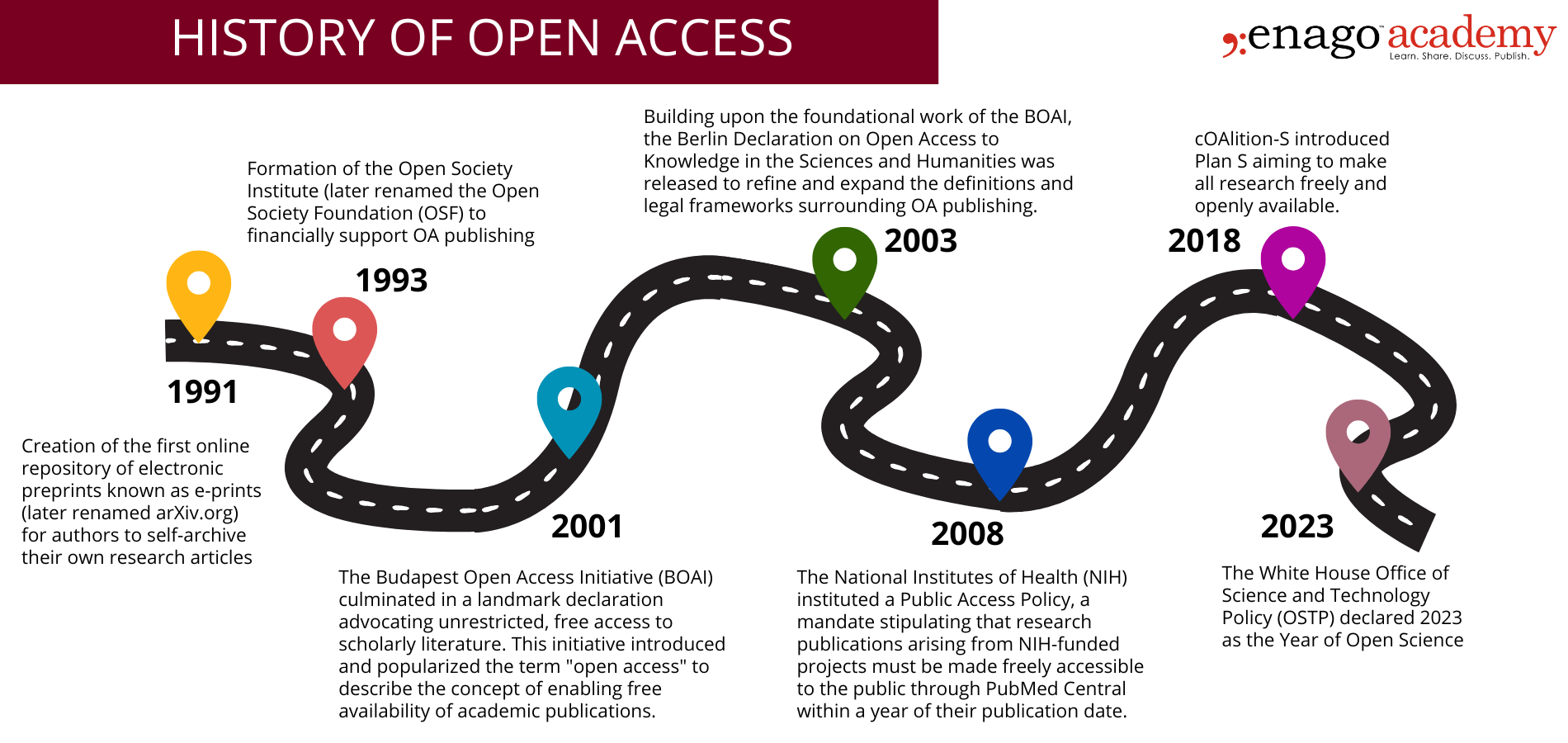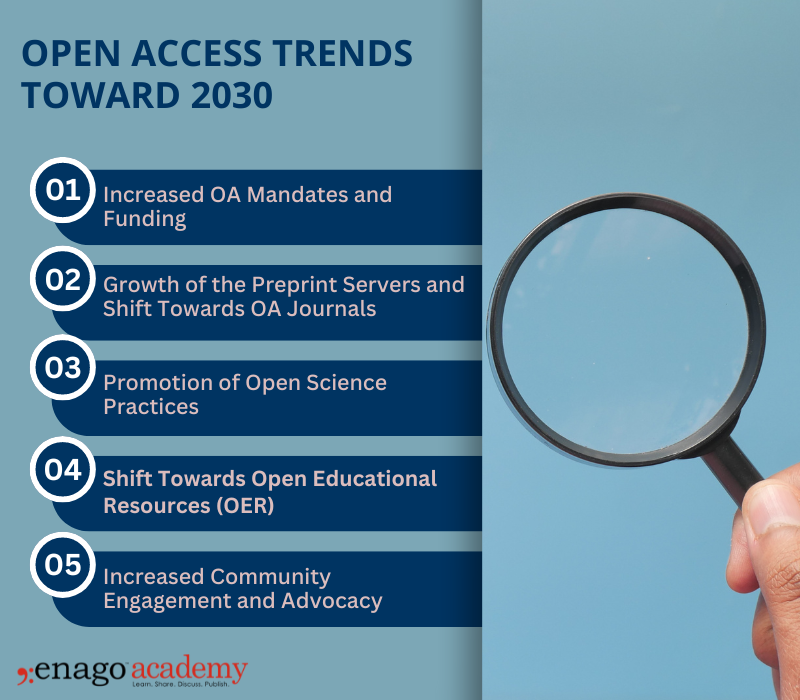Envisioning Scholarly Communication Through 2030: Analyzing trends in open science to chart the course of open access publishing

The Open Access (OA) movement has gained significant momentum in recent years, with researchers, publishers, and policymakers showing interest to promote accessibility of scholarly work. As we approach 2030, it is crucial to analyze the trends shaping the open science landscape to envision a sustainable future of scholarly communication.
Shifting Attitudes and Accelerating Progress
Over the past decade, the U.S. government has taken steps to promote open science by making federally funded research more accessible to the public. Furthermore, with the growing advocacy and policies promoting open science, the White House Office of Science and Technology Policy (OSTP) declared 2023 as the Year of Open Science. They further emphasized upon the indispensable role of federal agencies in developing and promoting innovative and inclusive open science policies.
Here is a glimpse through the pivotal moments in the history of OA publishing:

Additionally, initiatives like PlanS, launched by an international consortium of research funders, have accelerated progress toward open science by mandating that publications resulting from research funded by participating organizations be made openly available. This paradigm shift has prompted researchers, institutions, and publishers to adapt their practices and embrace the principles of open science.
Several measures have accelerated progress towards open science. One of them is advocating unrestricted access to research outputs. This momentum has influenced the policies of funding agencies and institutions. Additionally, it also spurred a cultural shift within the academic community, emphasizing the importance of transparency, collaboration, and accessibility in scholarly communication.
Growth of Open Access Publishing
The growth of OA publishing has been exponential, with steady increase in the number of OA journals, hybrid journals, and OA repositories. Here are some common factors that contributed to the growth of OA publishing:
Furthermore, tools like Enago OA Journal Finder can play a pivotal role in guiding researchers through their OA publishing journey. These platforms allow researchers to identify relevant OA journals, thereby contributing to the advancement of open science.
As several continued efforts have been instrumental in development of OA, here are the latest developments around OA publishing.
1. BMGF Introduces 2025 Open Access Policy
The Bill and Melinda Gates Foundation (BMGF) expanded their OA policies to apply them to all the published research and any underlying data, partly or fully funded by the organization. The new policy, effective January 1, 2025, is applicable for all grants awarded from January 1, 2015. It intends to promote the OA policy and broaden reach and its impact. Furthermore, the funded manuscripts needs to be shared in the form of a preprint. However, this policy is inapplicable to opinion pieces, white papers, key learnings reports, policy positions, etc.
2. The Prices of APCs Shoot Upwards
A study conducted by Enago Academy on OA publishing, article processing charges (APCs), and funding revealed that 80% researchers perceived APCs as expensive. 57% refrained publishing in OA journals due to unaffordable APCs. Additionally, a recent data analysis spanning over 20,000 journal titles revealed a significant increase in APC in 2024. Their statistics revealed a rise in prices of around 9.5% on average for fully OA journal and 4.3% for hybrid OA journals. These findings not only highlight the threat of soaring OA publishing costs but also signals a potential threat in the impediment of OA publishing.
The growth of OA publishing can be attributed to a combination of technological advancements, policy developments, and shifting attitudes within the academic community; all of which converge to promote a more open and inclusive approach to scholarly communication.
Anticipated Trends in Open Science Toward 2030
The growth of OA publishing has been remarkable, with an increasing number of OA journals, hybrid journals (offering both subscription and OA options), and OA repositories emerging to meet the demand for open access. According to the reports, over 19,000 journals listed in the Directory of Open Access Journals (DOAJ) were OA as of November 2023, of which 10000 were fully OA. Although the future of scholarly communication and OA publishing remains uncertain, here are the five trends that we envision as we look toward 2030.
 1. Increase in OA Mandates and Funding
1. Increase in OA Mandates and Funding
Governments and funding agencies are likely to continue mandating OA publication for publicly funded research, driving more researchers and institutions towards sustainable OA models. Furthermore, open science is likely to become more global, with emerging economies playing a larger role in promoting OA. However, researchers, publishers, and institutions may need to address challenges related to language barriers, infrastructure limitations, and funding disparities to ensure equitable participation in OA publishing initiatives.
2. Growth of Preprint Servers and Shift Towards OA Journals
Preprint servers have grown significantly, allowing researchers to share their findings before the formal peer review process. This trend is likely to continue in the coming years, impacting the traditional subscription-based publishing models. Furthermore, the number of OA journals is expected to grow, with more traditional publishers offering OA options and new OA-only journals emerging in various disciplines. However, the reported rise in APCs and unaffordability associated with it may impede this transition. As a result, journals may need to propose alternative and sustainable models to ensure affordability.
3. Promotion of Open Science Practices
To facilitate broader adoption of open science, researchers would be expected to share the underlying data, codes, software, research methodologies, etc. This may lead to the development of new tools and platforms for open data sharing, transparent methodologies, and reproducibility. As a result, researchers may need to adopt new workflows and tools for data sharing and reproducibility.
4. Shift Towards Open Educational Resources (OER)
The integration of OA principles into educational resources is likely to continue with growing emphasis on the creation and dissemination of open educational materials. This would provide new opportunities for researchers to contribute to OER initiatives. However, publishers and institutions may need to develop policies and infrastructure to support the creation and dissemination of OER.
5. Increased Community Engagement and Advocacy
Increased engagement and advocacy efforts from the scholarly community, libraries, and OA advocates may lead to greater awareness and support for OA publishing initiatives. As a result, institutions may refine policies, invest in OA infrastructure, and foster collaboration, thereby enhancing the career prospects of researchers. Furthermore, with increased advocacy, publishers may innovate new OA models and align their practices with evolving scholarly values, driving inclusive publishing landscape.
Overall, the future of OA publishing is likely to be shaped by a combination of technological innovation, policy changes, and shifts in scholarly communication practices, with implications for researchers, publishers, and institutions across the academic ecosystem.
The continued adoption of open science principles and the increasing emphasis on transparency, reproducibility, and public engagement suggest that OA publishing will become the norm rather than an exception. Publishers may need to adapt their business models further to align with the shifting landscape, embracing innovative approaches to funding and sustaining high-quality OA publications.
Frequently Asked Questions
Open access publishing is important as it improves research access, enables wider dissemination of knowledge and enhance researcher visibility. Furthermore, it helps in accelerating scientific progress and ensures long-term preservation of scholarly work.
5 trends in open science shaping the future of open access publishing include Increase in OA mandates and funding, Growth of the preprint servers and rising shift towards OA journals, Promotion of open science practices, Shift towards open educational resources (OER), and Increased community engagement and advocacy.















